1996 CHEVROLET BLAZER seats
[x] Cancel search: seatsPage 7 of 392

Downloaded from www.Manualslib.com manuals search engine The 1996 Chevrolet Blazer Owner’s Manual
Seats and Restraint Systems ............................................................. 1-1
This section tells you how to use your seats and safety belts properly. It also explains the “SIR” system.
Features and Controls .................................................................. 2-1
This section explains how to start and operate your vehicle.
Comfort Controls and Audio Systems ..................................................... 3-1
This section tells you how to adjust the ventilation and comfo\
rt controls and how to operate your
audio system.
Here
you’ll find helpful information and tips about the road and how to drive under different conditions.
This section tells you what
to do if you have a problem while driving, such as a flat tire or overheat\
ed
engine, etc.
Here the manual tells you how to keep your vehicle running pr\
operly and looking
good,
This section tells you when to perform vehicle maintenance and what fluids and lubricants to u\
se.
This section
tells you how to contact Chevrolet for assistance and how to get se\
rvice publications.
It also gives you information on “Reporting Safety Defects” on page 8-8.
YourDrivingandtheRoad .............................................................. 4-1
ProblemsontheRoad .................................................................. 5-1
ServiceandAppearanceCare ............................................................ 6-1
Maintenanceschedule .................................................................. 7-1
Customer Assistance Information ........................................................ 8-1
Index ........................................................................\
....
Here’s an alphabetical listing of almost every subject in this manual. You can use it to quickly find
something
you want to read.
- - 9-1
i
Page 13 of 392
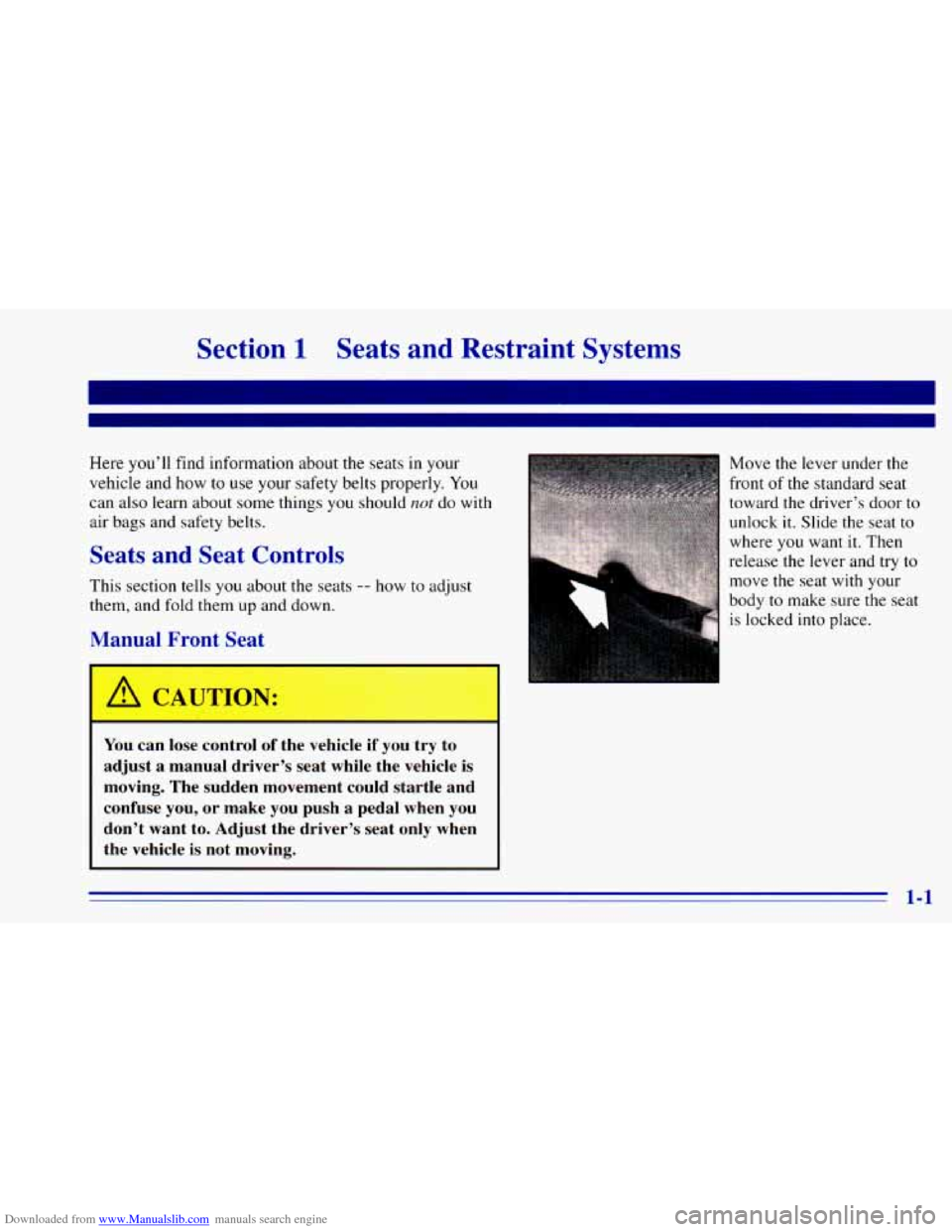
Downloaded from www.Manualslib.com manuals search engine Section 1 Seats and Restraint Systems
Here you’ll find information about the seats in your
vehicle and how
to use your safety belts properly. You
can also learn about some things you should not do with
air bags and safety belts.
Seats and Seat Controls
This section tells you about the seats -- how to adjust
them, and fold them up and down.
Manual Front Seat
You can lose control of the vehicle if you try to
adjust a manual driver’s seat while the vehicle is
moving. The sudden movement could startle and
confuse you, or make you push a pedal when you
don’t want
to. Adjust the driver’s seat only when
the vehicle
is not moving.
Move the lever under the
front of the standard seat
toward the driver’s door to
unlock
it. Slide the seat to
where
you want it. Then
release the lever and try to
move the seat with your
body,to make sure the seat
is locked into place.
1-1
Page 14 of 392
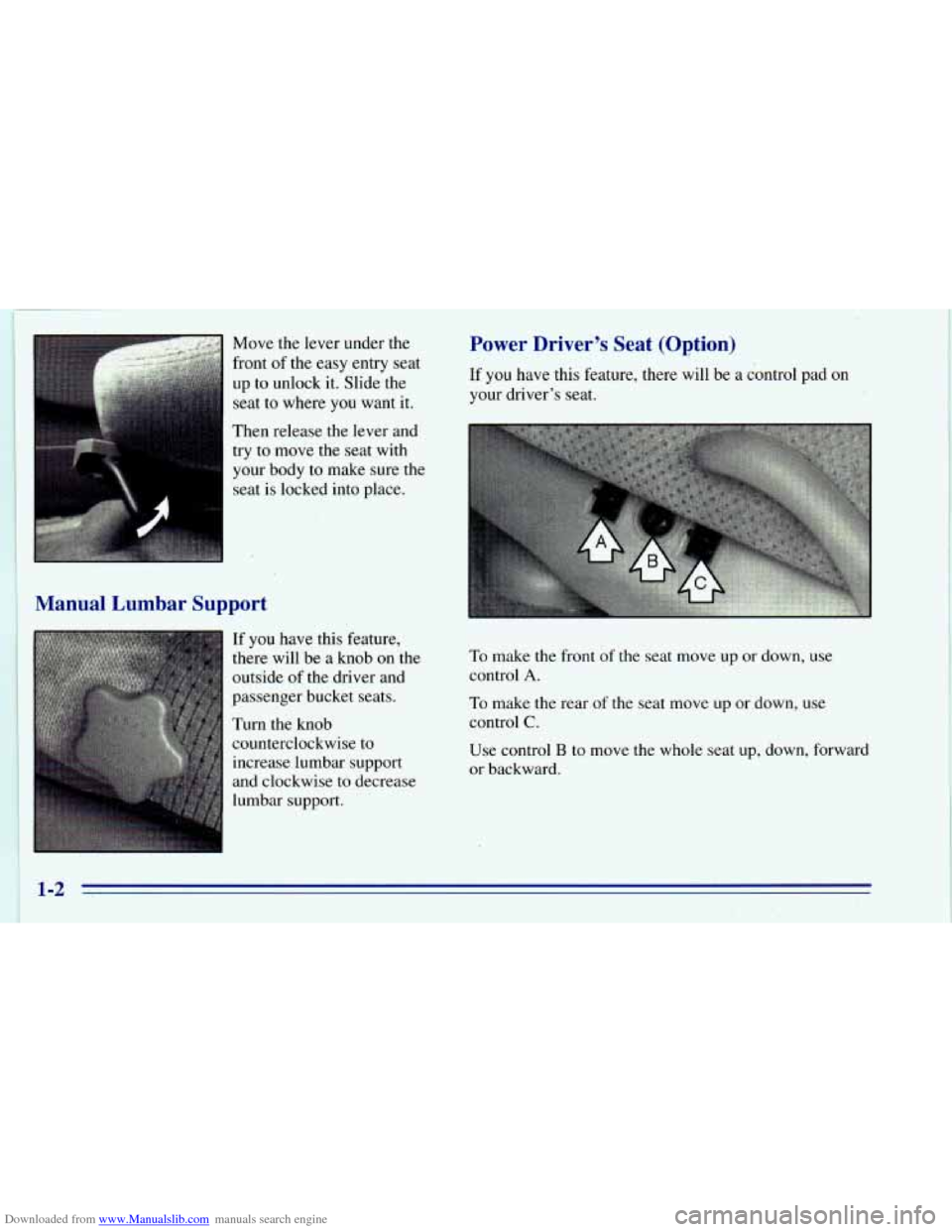
Downloaded from www.Manualslib.com manuals search engine I
Move the lever under the
front of the easy entry seat
up to unlock it. Slide the
seat to where you want it.
Then release the lever and
try to move the seat with
your body to make sure the
'seat
is locked into place.
I
Manual Lumbar Support
If you have this feature,
there will'be a knob on the
outside of the driver and
passenger bucket seats.
Turn the knob
counterclockwise to
increase lumbar support
and clockwise to decrease
lumbar support.
Power Driver's Seat (Option)
If you have this feature, there will be a control pad on
your driver's seat.
To make the front of the seat move up or down,.use
control
A.
To make the rear of the seat move up or down, use
control C.
Use control
B to move the whole seat up, down, forward
or backward.
1-2
Page 18 of 392
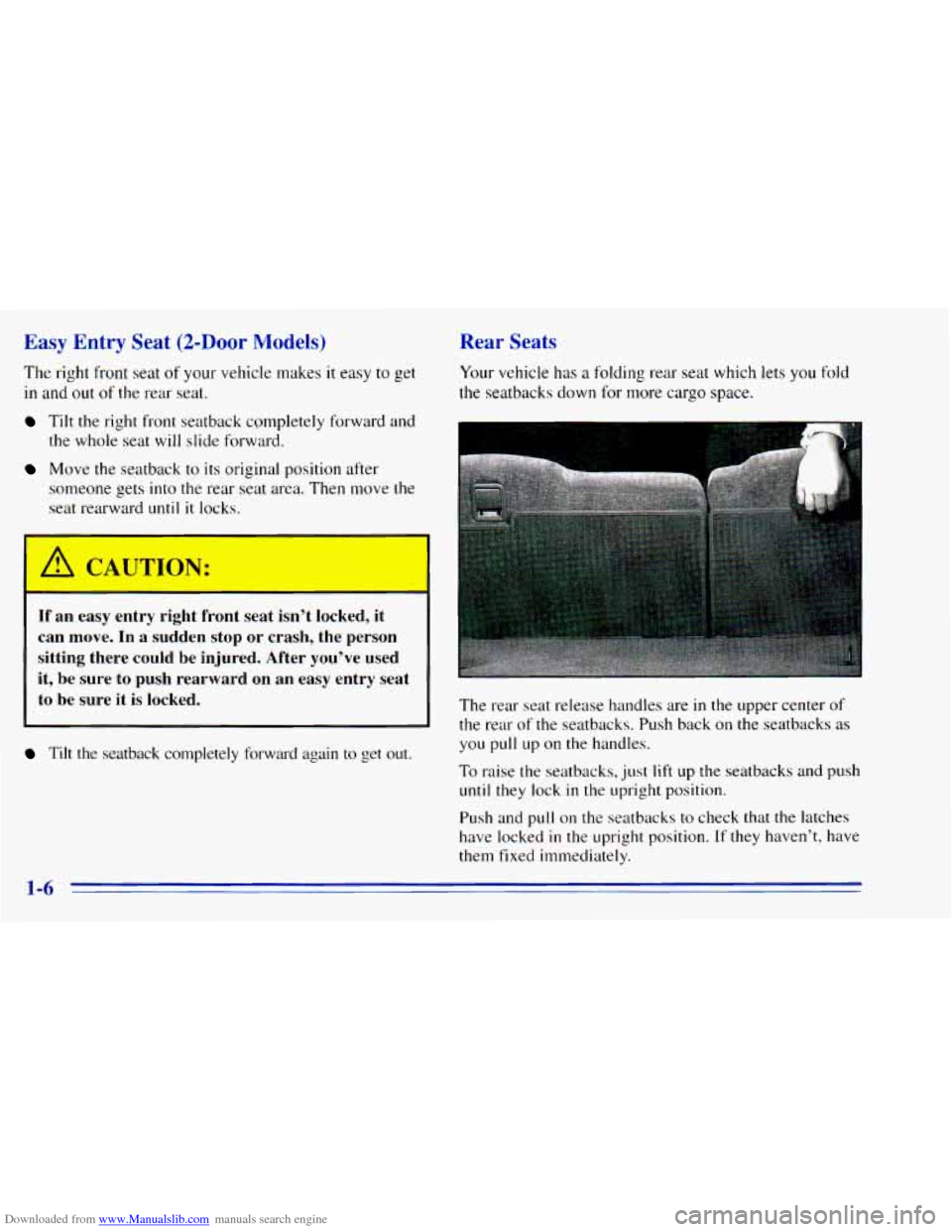
Downloaded from www.Manualslib.com manuals search engine Easy Entry Seat (2-Door Models)
The right front seat of your vehicle makes it easy to get
in
and out of the rear seat.
Tilt the right front seatback completely forward and
Move the seatback to its original position after
the whole seat
will slide
forward,
someone gets into the rear seat area. Then move the
seat rearward
until it locks.
If an easy entry right front seat isn’t locked, it
can move. In a sudden stop or crash, the person
sitting there could be injured. After you’ve used
it, be sure to push rearward on an easy entry seat
to be sure it
is locked.
Rear Seats
Your vehicle has a folding rear seat which lets you fold
the seatbacks down for more cargo space.
Tilt the seatback completely forward again to get out. The rear seat release handles
are
in the upper center of
the rear
of the seatbacks. Push back on the seatbacks as
you pull up on the handles.
To raise the seatbacks, just
lift up the seatbacks and push
until they lock in the upright position.
Push and pull on the seatbacks to check that
the latches
have locked
in the upright position. If they haven’t, have
them fixed immediately.
1-6
Page 24 of 392
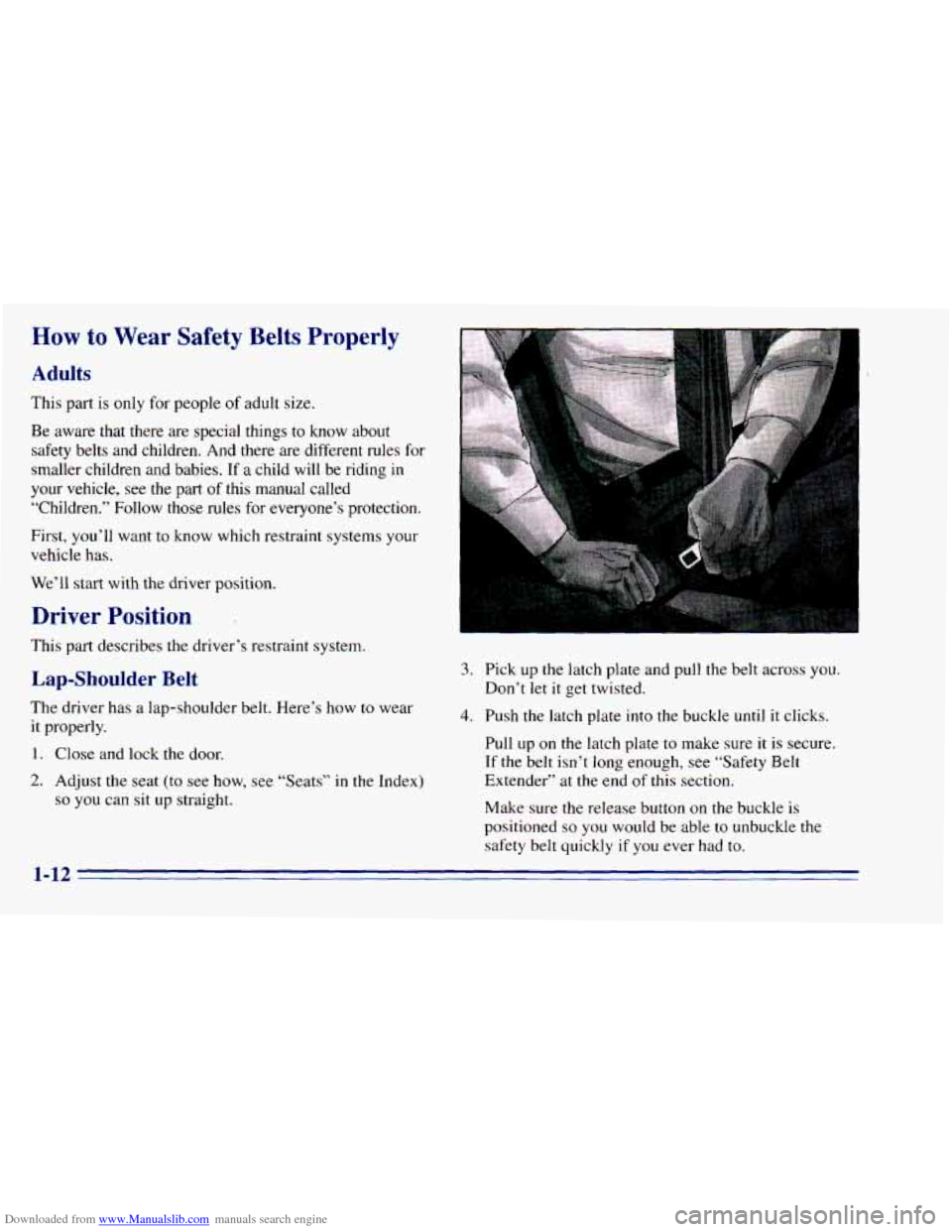
Downloaded from www.Manualslib.com manuals search engine How to Wear Safety Belts Properly
Adults
This part is only for people of adult size.
Be aware that there are special things to know about safety belts and children.
And there are different rules for
smaller children and babies, If a child will be riding in
your vehicle, see the part of this manual called
“Children.” Follow
those rules for everyone’s protection.
First,
you’ll want to know which restraint systems your
vehicle has.
We’ll start with the driver position.
Driver Position
This part describes the driver’s restraint system.
Lap-Shoulder Belt
The driver has a lap-shoulder belt. Here’s how to wear
it properly.
1. Close and lock the door.
2. Adjust the seat (to see how, see “Seats” in the Index)
so you can sit up straight.
:, .... : -
3. Pick up the latch plate and pull the be
Don’t let it get twisted.
:It across you.
4. Push the latch plate into the buckle until it clicks.
Pull
up on the latch plate to make sure it is secure.
If
the belt isn’t long enough, see “Safety Belt
Extender” at the end
of this section.
Make sure
the release button on the buckle is
positioned so you would be able to unbuckle the
safety belt quickly
if you ever had to.
1-12
Page 74 of 392

Downloaded from www.Manualslib.com manuals search engine Automatic Transmission Operation
Your automatic transmission may have a shift lever
located
on the console between the seats or on the
steering column.
There are several different positions for your shift lever.
If your vehicle is equipped with a column shift lever,
it
features an electronic shift position indicator within
the instrument cluster. This display must be powered
anytime
the shift lever is capable of being moved out
of the PARK (P) position. This means that if your key is
in the
OFF position, but not locked, there will be a small
current drain
on your battery which could discharge
your battery over
a period of time. If you need to leave
your key
in the ignition in the OFF position for an
extended period, it is recommended that you disconnect
the battery cable from the battery
to prevent discharging
your battery.
PARK (P): This locks your rear wheels. It’s the best
position
to use when you start your engine because your
vehicle can’t move easily.
D
It is dangerous to get out of your vehicle if the
shift lever is not fully in
PARK (P) with the
parking brake firmly
set. Your vehicle can roll.
Don’t leave your vehicle when the engine is
running unless you have to. If you have left the
engine running, the vehicle can move suddenly.
You or others could be injured.
To be sure your
vehicle won’t move, even when you’re on fairly
level ground, always set your parking brake and
move the shift lever to
PARK (P).
If you have four-wheel drive, your vehicle will
be free to roll
-- even if your shift lever is in
PARK (P) -- if your transfer case is in
NEUTRAL (N). So, be sure the transfer case is
in
a drive gear, two-wheel high (2HI) or four-wheel
high (4HI) or four-wheel low
(4LO) -- not
in
NEUTRAL (N). See “Shifting Into PARK (P)”
in the Index. If you’re pulling a trailer, see “Towing a
’Ikailer” in the Index.
2-16
Page 138 of 392

Downloaded from www.Manualslib.com manuals search engine Ventilation Tips
a
0
0
Keep the hood and front air inlet free of ice, snow or
any
other obstruction (such as leaves). The heater
and defroster will work far better, reducing the
chance
of fogging the inside of your windows.
When
you enter a vehicle in cold weather, turn the
blower fan to
HI for a few moments before driving
off. This helps clear the intake ducts of snow and
moisture, and reduces the chance
of fogging the
inside of your windows.
Keep
the air path under the front seats clear of
objects. This helps air
to circulate throughout
your vehicle.
Defogging and Defrosting
On cool, humid days, use BLEND to keep the
windshield and side windows clear.
Use DEFROST to remove fog or ice from the
windshield quickly in extremely humid or cold
conditions. Turn the temperature knob clockwise and move
the fan control toward HI.
Rear Window Defogger (Option)
1
If your vehicle has this option, the rear window will
have lines that warm the glass. For best results, clear the
window of
as much snow or ice as possible before using
the rear window defogger.
To turn on the rear window defogger, find
the switch
marked REAR
DEFOG on your instrument panel below
the headlamp switch. Press ON
until the light in the
switch conles on, then release
it. It will only work if the
ignition switch
is turned to RUN.
3-4
Page 199 of 392
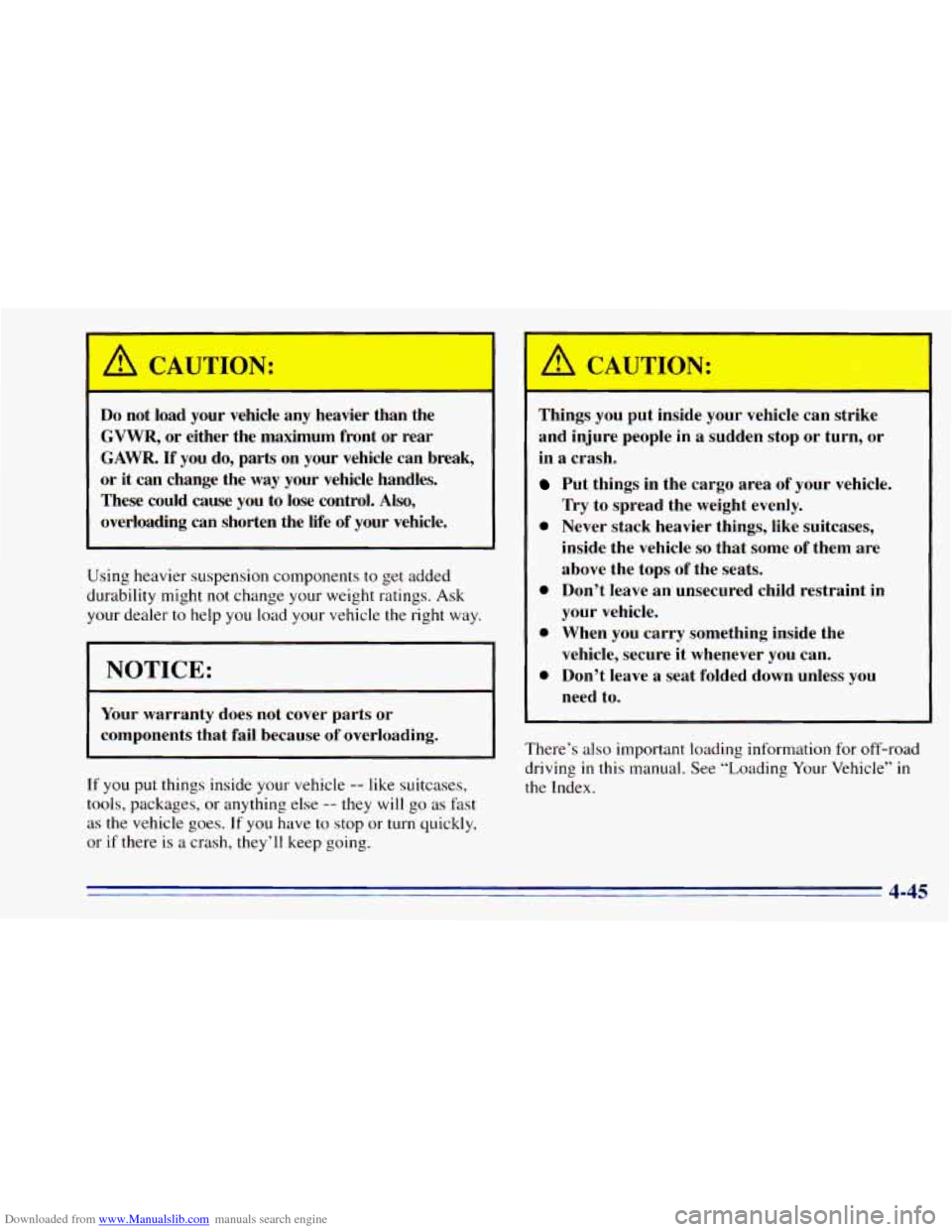
Downloaded from www.Manualslib.com manuals search engine A CAUTION:
= 1
Do not load your vehicle any heavier than the
GVWR, or either the maximum front or rear
GAWR.
If you do, parts on your vehicle can break,
or it can change the
way your vehicle handles.
These could cause you to lose control.
Also,
overloading can shorten the life of your vehicle.
Using heavier suspension components to get added
durability might not change your weight ratings. Ask
your dealer to help you load your vehicle the right way.
NOTICE:
Your warranty does not cover parts or
components that fail because of overloading.
~~
If you put things inside your vehicle -- like suitcases,
tools, packages, or anything else -- they will go as fast
as the vehicle goes. If you have to stop or turn quickly,
or if there
is a crash, they’ll keep going.
A CAUTION: ..,
Things you put inside your vehicle can strike
and injure people in
a sudden stop or turn, or
in a crash.
Put things in the cargo area of your vehicle.
0 Never stack heavier things, like suitcases,
Try to spread the weight evenly.
inside the vehicle
so that some of them are
above the tops
of the seats.
0 Don’t leave an unsecured child restraint in
your vehicle.
0 When you carry something inside the
vehicle, secure it whenever you can.
0 Don’t leave a seat folded down unless you
need to.
There’s also important loading information for off-road
driving
in this manual. See “Loading Your Vehicle” in
the Index.
4-45